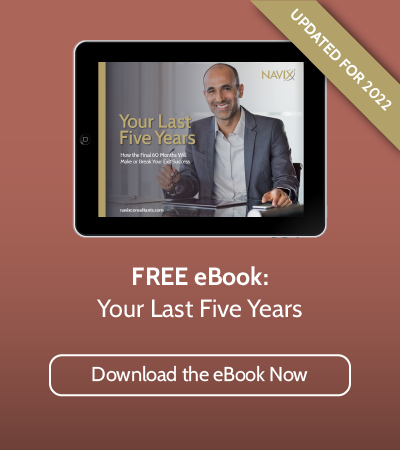By: Patrick Ungashick


The following case study is based on a true story. It highlights the importance of co-owners in a business recognizing their exit objectives may not be aligned. Owners need to plan their exit years prior to the event and work with an experienced team of advisors, like our NAVIX Consultants.
Download How One Business Owner Reduced Financial Dependency on His Business Case Study (PDF)
Key Lessons:
- Most business owners have the majority of their net worth tied up in their business, and the assets that their business supports. This creates risk and dependency on the business.
- The greater risk and sense of dependency the owner perceives, the more potential that owner will feel pressure to sell the business.
- There is a variety of tactics owners could consider short of an outright sale to diversify net worth, reduce risk, and take off some of that pressure to sell.
- “Exit planning” is not another name for selling a business. It is helping owners define their exit goals and working with them years in advance to position their companies and themselves to achieve exit success.
How One Business Owner Reduced Financial Dependency on His Business
When we first met Nate, he was anxious to put together an exit plan for his business, even though he didn’t want to exit. Nate was the founder, CEO and owner of PTI, a corporate training company. When he started the business twenty years earlier, he was only interested in doing the best job possible for a few key customers. He never expected the business to grow to $15 million in revenues, more than $2 million in pre-tax profits, no debt, and 50 employees. Twenty years ago, he had been a younger, newly married guy with a little money in the bank and a starter home. Now, he had a personal net worth in the many millions, and a business that provided for a comfortable lifestyle.
“That’s the problem,” he told us during our first meeting. “Don’t get me wrong, I am incredibly thankful and appreciative of what my business success has done for me and my family. I love this business and I don’t want to go anywhere.” But, he went on to say, “Everything I have depends on my business. If my business goes away, it would not be long before everything else would have to go away. I don’t want to have this much risk. I want to build up my personal assets. Sure, I want to sell my business one day so I can be free to do something else, but I don’t want to sell anytime soon, and certainly not before I decide for myself that I am ready.”
Nate had a strong personal net worth. However, pulling back the covers revealed that the substantial majority of his net worth was tied up in the business and in assets that the business supported: an office building, a small plane, and some personal real estate. Relative to his total net worth, Nate had minimal personal liquidity. The way Nate saw it, he would sell his business one day to reduce his personal risk, whether he wanted to or not.
Prior to meeting with us, Nate had consulted other advisors, and learned about several strategies to address his concerns about his wealth being concentrated in his business. The most common tactic he heard about was a private recapitalization which involves selling a portion of his business to an outside investor, such as a private equity group (PEG). This would allow him to partially cash out of the business, diversify his assets to reduce his risk, and still leave him leading the company and owning a significant percentage going forward. Nate did not like the idea. “Everybody keeps telling me I should do a ‘private recap.’ While that idea can work for some owners, but not for me. I don’t want a business partner. I am my own guy and I like it that way.”
Another suggestion was Nate’s business could borrow a significant amount of money and use the cash to pay him a one-time dividend, and then the business could pay down the debt over time. While the business could afford to do something like this, Nate was against taking on any significant debt. “It feels like I am just trading one type of risk for another,” he explained to us. A third idea suggested to him was to sell part of his business to an ESOP. Nate told us, “For me, that’s a double-negative. I’d have a business partner—the ESOP. And if I wanted the ESOP to pay me cash up front, we’d have to go into debt.”
Nate felt as if his success in business would force him to sell the company one day, long before he wanted to.
In our work providing exit planning solutions to business owners, we often encounter situations such as Nate’s. The owner’s success creates a dilemma—how to reduce risk and reach financial freedom with so much personal net worth tied up in the business? The good news is, there are solutions other than an outright sale.
Talking it through with Nate, we learned that he could be comfortable building up his personal net worth over the next few years, as long as he had a clear and reasonable plan for how he would do this. He did not feel like he had to do it all at once. Working closely with Nate’s accountant, we made several recommendations on strategies for Nate to pull more money out of his business each year on a pre-tax basis. First, we redesigned his company’s 401k plan to add a profit-sharing element that increased total plan contributions for Nate to over $50,000 per year, without significantly increasing contributions for the rest of his employees. Nate’s reaction was, “Well that’s a good start, but at $50k we have a long way to go yet.”
For the second tactic, we worked with Nate’s accountant and lawyer to set up an 831(b) captive insurance company owned by Nate. Nate’s business, PTI, would purchase insurance from the captive to cover many of his business’s uninsured operating risks. This created two benefits for him. First, the extra insurance from his captive gave Nate added peace of mind should the business experience a serious incident or loss. Second, under the relevant tax laws his captive could receive up to $1.2 million per year in premium income and not have to pay taxes on that income until he withdrew it, presumably later in life when he sells his business. Premiums paid by PTI, his company, to the captive would be income-tax deductible, if properly structured.
Between these two strategies, Nate might accumulate outside of his business about $5 million over the next four years ($1.25 million per year for four years), all on a tax-advantaged basis. Nate understood that this was not enough money for him to retire, but it greatly diversified his net worth and gave him a sense of breathing room, taking away the pressure he felt from having most of his assets tied up in the business.
Once these tactics were successfully implemented, Nate turned to our team and said, “I thought an ‘exit plan’ was just helping me sell my business. I get now that it’s much more involved. So where were you guys five years ago? I could have saved myself all this grief if I had just started earlier.”








